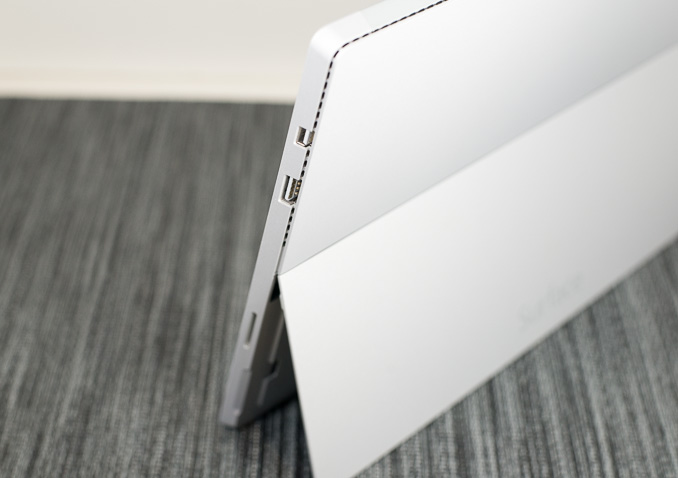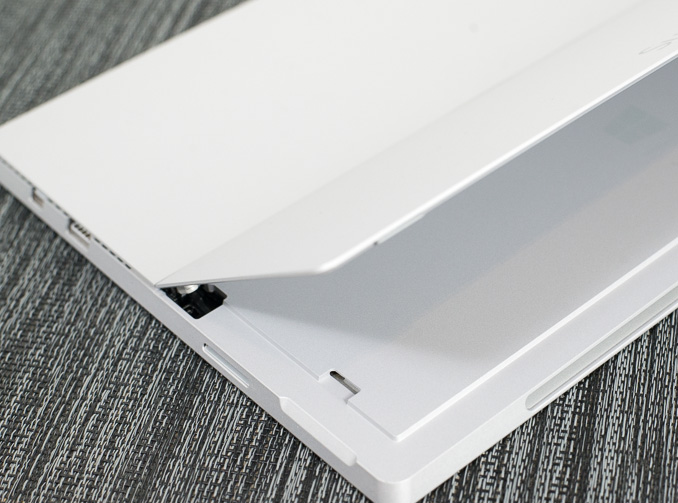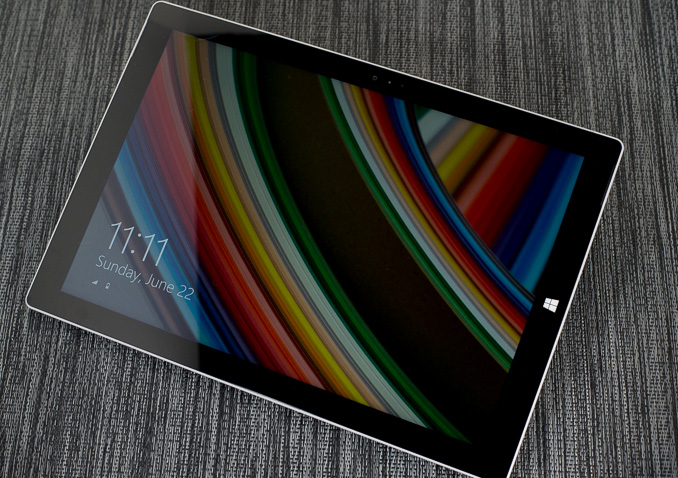Microsoft Surface Pro 3 Review
by Anand Lal Shimpi on June 23, 2014 3:55 AM ESTFinal Words
When I reviewed the first Surface Pro I was intrigued by the idea, but felt it needed a few more iterations to get to the right point. In less than two years what we have in front of us looks very different than Microsoft's original vision for the platform. Display size, aspect ratio and even the mechanics of the whole thing are all quite different. The changes are for the better as Surface Pro 3 is a much better laptop and a much better tablet than any of its predecessors. The device no longer feels cramped and tiring to use as a laptop. The new Surface Pro no longer feels heavy to use as a tablet either. It's truly an improvement on both vectors.
Microsoft might be overselling the design to say that it truly is the only device you need. Like most compromises, Surface Pro 3 isn't the world's best laptop nor is it the world's best tablet. It serves a user who wants a little of column A and a little of column B.
The device's "lapability" is tremendously better than any of its predecessors. While I wrote all of the previous Surface reviews on the very Surface devices I was reviewing, this is by far the most comfortable one to use as a laptop. It's still not perfect, and you still need a fairly long lap to make it work, but the design is finally really usable as a laptop.
As a tablet the thinner and lighter chassis is much appreciated. The new kickstand remains one of the best parts of the design, enabling a flexibility unmatched by any other tablet. Tent mode in particular is awesome for tablet usage models.
Surprisingly enough the move away from Wacom to an active NTrig pen model comes with very few issues. The device could use some tuning of its pen pressure curves. Applying max pressure on the screen now distorts the LCD, something I'm never comfortable doing. But overall the new pen gives up very little and even improves performance and functionality.
The new Type Cover is awesome. The keyboard is probably as good as it's going to get, and the new trackpad is finally usable. The latter isn't perfect but it's so much better than anything that's come before it.
The device also launches with a far more polished version of Windows. With its latest updates, Windows 8.1 is a far cry from where it first started. I still think there's lots of room for improvement, but it's clear that Microsoft is marching towards a more cohesive vision of modern and desktop Windows UIs.
The downsides for Surface Pro 3 are obvious. Windows 8.1 remains a better desktop/notebook OS than a tablet OS. Yet in a device like Surface Pro 3 where you're forced to rely on touch more thanks to a cramped trackpad, I'm often in a situation where I'm interacting with the Windows desktop using the touchscreen - a situation that rarely ends well. As Microsoft improves the behavior of its modern UI apps, I would love to see a rethinking of what touch looks like on the desktop. If Surface Pro 3 exists to blur the lines between laptop and tablet, Windows 9 needs to do a better job of the same. The desktop needs to react better to touch and the modern apps need to feel even more integrated into the desktop.
On the hardware side, the device is a compromise. You have to be willing to give up some "lapability" in order to get a unified laptop/tablet device. Whether what you get as a tablet is worth the tradeoff is going to be up to how good of a tablet OS Windows 8.1 is for you. Personally I find that Android and iOS deliver better tablet experiences particularly when it comes to 3rd party applications. If everything you need on the tablet front is available in the Windows Store however then the point is moot.
Those users upgrading from Surface Pro 2 may notice a regression in performance, particularly when it comes to running prolonged CPU/GPU intensive workloads. In games, the difference can be noticeable. The simple fact is that in becoming a thinner device, Surface Pro 3 inherited more thermal constraints than its predecessors. While performance regressions aren't ideal, in this case I can appreciate what Microsoft has done. From the very beginning I wanted a lower TDP part in a thinner chassis. Had Microsoft done that from the start we wouldn't have seen any performance regression but rather a steady increase over time. From my perspective, Surface Pro 3 is simply arriving at the right balance of thermals and performance - the previous designs aimed too high on the performance curve and required an unreasonably large chassis as a result.
The remaining nitpicks are the same as last time: Microsoft needs to embrace Thunderbolt, and a Type Cover should come with the device. The display's color accuracy is good but grayscale performance needs some work.
Surface Pro 3 is easily the best design Microsoft has put forward. If you were intrigued by the previous designs, this is the first one that should really tempt you over. I was a fan of the original Surface Pro, and with Surface Pro 3 I think Microsoft has taken the hardware much closer to perfection. At this point the design needs more help on the software side than hardware, which is saying a lot for the Surface Pro hardware team. Personally I'd still rather carry a good notebook and a lightweight tablet, but if you are looking for a single device this is literally the only thing on the market that's worth considering. I don't know how big the professional productivity tablet market is, but it's a space that Microsoft seems to have almost exclusive reign over with its Surface line. With its latest iteration, Microsoft is serving that market better than ever.













274 Comments
View All Comments
darwinosx - Tuesday, June 24, 2014 - link
Exactly. It's a lousy laptop and an even worse tablet.ESC2000 - Saturday, July 5, 2014 - link
Have you actually, you know, purchased the surface pro 3 and.... used it? I'm assuming so if you're making such bold claims. I own one and it's great... Amazing improvement over the first gen which I also own.And I have owned an mba before and it was fine but the surface is better overall imo.
savaytse66 - Monday, June 23, 2014 - link
Well, this is the device basket in which I'm throwing all of my eggs. My mobile devices are currently a 2006 Dell 17" laptop running Windows 7 and an HP Touchpad running CM10.1. I've been waiting to upgrade until the right "hybrid" device came along, and this is the one I'm banking on, albeit the i7/512 model.My usage is a little atypical. My work requires me to occasionally spend time on construction sites creating sketches and recording measurements. I am hoping this device will allow me to skip the full size (24" x 36" or larger) architectural prints and the paper sketch pad and simply carry everything on the SP3. After I finish on site, I am often going back to a hotel room for the night, or spending the next few hours in an airport/airplane. I make heavy use of AutoCAD, and being able to make tweaks in the field, or even the hotel, should be amazingly helpful. I don't expect to be at full productivity, but then again, even on a typical laptop, running AutoCAD on one small screen will never be as productive as running on 2 or 3 large desktop displays.
In theory, the SP3 should be perfect for me. I do worry about the batter life though. I suspect that I might need to pick up an external battery pack for those times I'm on site without access to a wall outlet. Time will tell, I guess. I also think about general durability. I am generally not on fully active construction sites with lots of dirt and dust, but I will be in environments that are not office-like. So we'll see if there is some sort of rugged case or screen protection available for those scenarios.
All in all, I am really looking forward to getting my SP3 in August. I just wish they would release it already since I could really use it mid-July. But I've waited this long, so what's another couple of weeks.
Thanks for the nice review. This is the one I've been waiting for, and it didn't disappoint.
Papa - Monday, June 23, 2014 - link
I'd make sure you can run AutoCad on a HD4400 smoothly. Nothing worse than dragging etc and getting lag, especially in more 3D spaces.savaytse66 - Monday, June 23, 2014 - link
Make no mistake, my production machine is, and always will be my desktop workstation. My mobile solution now for MINOR AutoCAD work is Remote Desktop or TeamViewer, oftentimes tethered to my cell phone, so if running it natively, even on integrated graphics, isn't more smooth than that, then I'm in trouble!Since I'm mostly in a 2D workspace, I'm pretty confident.
Drumsticks - Monday, June 23, 2014 - link
Additionally, I'm 99% sure they confirmed that the i7 model is a 4650U with HD5000 graphics, which maybe helps a bit. TDP limited sure, but hopefully you see something.Drumsticks - Monday, June 23, 2014 - link
Edit: I has good charts skills 4 readingxerandin - Monday, June 23, 2014 - link
It doesn't have to run well on an HD4400, because the model he chose is an HD5000.MonkeyPaw - Monday, June 23, 2014 - link
Considering how quickly the Surface line charges, you could probably just spam charge it in your vehicle or find an outlet at lunch and get through your work day.Shaedo - Tuesday, July 22, 2014 - link
Might be too late for you but you're describing the Q704 by Fujitsu which is equivalent specs to a Surface pro 3, came out a long time ago and most importantly is dust and water proof.http://www.shopfujitsu.com/store/mobileconfigurato...